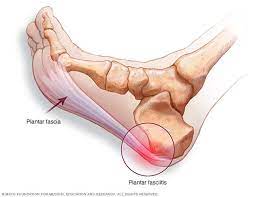Plantar Fasciitis
At Hurst Podiatry, we offer treatments to help people who may be suffering from Plantar Fasciitis at our clinics in Healesville, Croydon, Kilsyth and Mooroolbark.
If you’re experiencing pain or any issues with your feet and/or lower limbs in Melbourne, book an appointment to see us now.
What is plantar fasciitis?
The plantar fascia is a piece of fibrous connective tissue on the sole of your feet, it runs from your heel bone to about where the webbing of your toes start.
The plantar fascia is basically the most superficial layer on the sole of your foot with the exception of the skin, it works to stop the foot collapsing too much when weight bearing and to absorb load and pressure during walking.
Put simply plantar fasciitis is when the plantar fascia becomes inflamed through repetitive trauma or more acute straining and tearing. The plantar fascia should be around 3.8mm thick but we often see more severe cases where it has almost doubled in size and in particularly nasty cases it can even tear in several places. At this point people often have trouble walking on the affected foot.


What causes Plantar Fasciitis?
Plantar fasciitis is amongst the most common injuries of the foot with some studies showing it accounts for about 10% of all foot injuries. This can happen for a variety of reasons but amongst the more common are overuse, unsupportive shoes, flat feet that collapse, too much time on hard surfaces or sudden increases in training volume. Our team can help you work out if you have plantar fasciitis, how severe it is, what the cause is and most importantly how to improve it!
What treatments are available for Plantar Fasciitis?
Lots!
As plantar fasciitis is such common injury but can have a large number of different causes our staff are trained with a large number of treatment options to get you moving again.
These options include:


Rehabilitative exercises
Programs designed to help create mobility and strength can help overcome some of the weaknesses and deficiencies that lead to plantar fasciitis in the first place. We can help build such a program through you through our digital physitrack program.
Hot/cold therapy
Hot and cold therapies can be used to limit swelling and inflammation or to stimulate blood flow both have their role to play in helping with musculoskeletal injuries like plantar fasciitis. As a rule heat is used for old injuries where healing is being encouraged and heat for more acute injuries but we can help guide you through this.
Changing your running and exercise habits
Running and walking technique which is influenced by the shape of our feet and the way we use them can have a huge say in creating plantar fasciitis injuries. We have a digital gait room at our head office we use to analyse your gait and help identify any problems that may be contributing to your plantar fasciitis
Shockwave therapy
Shockwave therapy involves using a therapy unit on the site of the injury to stimulate new healing and blood flow. You can learn more about its benefits on the services section of our website.
K laser therapy
K laser therapy involves using photobiomodulation via UV frequencies on chromophores(specfic body cells) to create positive healing changes like stimulating blood flow, increasing collagen production, stimulating and boost cell production. There are only a handful of K lasers available in the state and we are lucky enough to have one at our clinics. You can learn more about K laser on the K laser section of our services website page.
Dry needling
Dry needling involves using acupuncture needles on trigger points or “knots” to help release muscle tension and tightness. We know tightness and tension in certain muscles of the body can result in plantar fasciitis these are the ones we target during treatment. We have more information on dry needling in the services portion of our website.
Orthotics
Orthotics are shoe inserts that can be placed in footwear to correct and realign the foot and improve its dynamic function. They come in a variety of styles and materials and can be used to great effect on plantar fasciitis. To find more information on orthotics please look in the services section on our website.
Moon boots
Moon boots are a rigid plastic boot that can be used similarly to a plaster cast to immobilise and offload the foot. They are great when an injury is too severe to continue to walk on and needs a period of rest. They can be used in plantar fasciitis in more severe cases.
Taping and strapping
There are number of taping and strapping techniques we can employ that help support the plantar fascia and reduce stress on the area to reduce symptoms.
Topical NSAIDs and AI’s
Topical NSAIDS and AI’s including things like arnica, fisiocrem or voltaren they can be very handy when applied to the area affected by plantar fasciitis for managing symptoms
Discussing footwear changes
Wearing the wrong kind of shoes can be contributory and in some cases the sole cause of plantar fasciitis. We can help discuss whether you are wearing the right types of shoes of whether it is time for a change.
Massage
Self massage using a spikey therapy ball can be a really good ay of reducing plantar fasciitis we have these available for purchase at our clinics.
Cortisone injection
Cortisone injections guided under ultrasound can be very helpful for more severe cases of plantar fasciitis. Whilst these are performed currently by our team we can help steer you towards someone who can provide one if we think that is the best course of action.
Surgery
It is rare that plantar fasciitis ever requires surgery but in some very stubborn and difficult cases this ends up being the last resort. We have access by referral to some of the best surgeons in the country and can help work through this with you if need be.
Frequently Asked Questions
-
How do I know if I have Plantar Fasciitis?
The most common symptoms for plantar fasciitis are pain in the arch and the heel typically after periods of non-weight bearing. Patients will often report noticing the pain first thing in the morning in particular. The pain is most commonly described as a deep ache or bruised feel often people will begin to experience pain on the other foot or other areas of the foot as they try to compensate and walk on other less painful regions of the foot.
We can help you determine definitively what your injury is through a series of clinical tests and if needed diagnostic imaging like xray, ultrasound, MRi or a CT scan.
-
How long will it take to get better from Plantar Fasciitis?
More than most lower limb injuries plantar fasciitis can vary in how long it takes to recover from. In some cases the answer is days or weeks and in some cases it can be months or even years for some poor feet. We do know that we see much quicker recovery times in patients who attend shortly after they start getting symptoms. The longer plantar fasciitis is left untreated the longer it tends to take to come good and the more therapy and financial outlay is normally required. So help us help you and get in to see our team ASAP!
-
Do I need orthotics for plantar fasciitis?
Not always. Orthotics are potentially a wonderful treatment option for plantar fasciitis, but they are certainly not the only option. Orthotics are great if the cause of your plantar fasciitis is due largely to the shape of your foot and the way that you walk. This is certainly not the only cause though of plantar fasciitis though, by talking to you about your condition and how you got there we can help you work out whether or not orthotics is good option for you or not.
